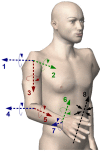A survey on robotic devices for upper limb rehabilitation
- PMID: 24401110
- PMCID: PMC4029785
- DOI: 10.1186/1743-0003-11-3
A survey on robotic devices for upper limb rehabilitation
Abstract
The existing shortage of therapists and caregivers assisting physically disabled individuals at home is expected to increase and become serious problem in the near future. The patient population needing physical rehabilitation of the upper extremity is also constantly increasing. Robotic devices have the potential to address this problem as noted by the results of recent research studies. However, the availability of these devices in clinical settings is limited, leaving plenty of room for improvement. The purpose of this paper is to document a review of robotic devices for upper limb rehabilitation including those in developing phase in order to provide a comprehensive reference about existing solutions and facilitate the development of new and improved devices. In particular the following issues are discussed: application field, target group, type of assistance, mechanical design, control strategy and clinical evaluation. This paper also includes a comprehensive, tabulated comparison of technical solutions implemented in various systems.
Figures



Similar articles
-
Pneumatic robotic systems for upper limb rehabilitation.Med Biol Eng Comput. 2011 Oct;49(10):1145-56. doi: 10.1007/s11517-011-0814-3. Epub 2011 Aug 6. Med Biol Eng Comput. 2011. PMID: 21822631 Review.
-
A planar 3DOF robotic exoskeleton for rehabilitation and assessment.Annu Int Conf IEEE Eng Med Biol Soc. 2007;2007:4024-7. doi: 10.1109/IEMBS.2007.4353216. Annu Int Conf IEEE Eng Med Biol Soc. 2007. PMID: 18002882
-
A review of methods for achieving upper limb movement following spinal cord injury through hybrid muscle stimulation and robotic assistance.Exp Neurol. 2020 Jun;328:113274. doi: 10.1016/j.expneurol.2020.113274. Epub 2020 Mar 5. Exp Neurol. 2020. PMID: 32145251 Review.
-
Advances in upper limb stroke rehabilitation: a technology push.Med Biol Eng Comput. 2011 Oct;49(10):1103-18. doi: 10.1007/s11517-011-0797-0. Epub 2011 Jul 20. Med Biol Eng Comput. 2011. PMID: 21773806 Review.
-
System Framework of Robotics in Upper Limb Rehabilitation on Poststroke Motor Recovery.Behav Neurol. 2018 Dec 13;2018:6737056. doi: 10.1155/2018/6737056. eCollection 2018. Behav Neurol. 2018. PMID: 30651892 Free PMC article. Review.
Cited by
-
A review of soft wearable robots that provide active assistance: Trends, common actuation methods, fabrication, and applications.Wearable Technol. 2020 Sep 14;1:e3. doi: 10.1017/wtc.2020.4. eCollection 2020. Wearable Technol. 2020. PMID: 39050264 Free PMC article. Review.
-
The Use of Head-Mounted Display Systems for Upper Limb Kinematic Analysis in Post-Stroke Patients: A Perspective Review on Benefits, Challenges and Other Solutions.Bioengineering (Basel). 2024 May 24;11(6):538. doi: 10.3390/bioengineering11060538. Bioengineering (Basel). 2024. PMID: 38927774 Free PMC article. Review.
-
Design and Control of an Upper Limb Bionic Exoskeleton Rehabilitation Device Based on Tensegrity Structure.Appl Bionics Biomech. 2024 Aug 29;2024:5905225. doi: 10.1155/2024/5905225. eCollection 2024. Appl Bionics Biomech. 2024. PMID: 39239384 Free PMC article.
-
Advances and Challenges in Spinal Cord Injury Treatments.J Clin Med. 2024 Jul 13;13(14):4101. doi: 10.3390/jcm13144101. J Clin Med. 2024. PMID: 39064141 Free PMC article. Review.
-
Data-Driven Optimal Assistance Control of a Lower Limb Exoskeleton for Hemiplegic Patients.Front Neurorobot. 2020 Jul 3;14:37. doi: 10.3389/fnbot.2020.00037. eCollection 2020. Front Neurorobot. 2020. PMID: 32719595 Free PMC article.
References
-
- Platz T. Evidenzbasierte Armrehabilitation: Eine systematische Literaturübersicht [Evidence-based arm rehabilitation–a systematic review of the literature] Nervenarzt. 2003;74(10):841–849. doi: 10.1007/s00115-003-1549-7. [ http://dx.doi.org/10.1007/s00115-003-1549-7] - DOI - DOI - PubMed
-
- Feys H, Weerdt WD, Verbeke G, Steck GC, Capiau C, Kiekens C, Dejaeger E, Hoydonck GV, Vermeersch G, Cras P. Early and repetitive stimulation of the arm can substantially improve the long-term outcome after stroke: a 5-year follow-up study of a randomized trial. Stroke. 2004;35(4):924–929. doi: 10.1161/01.STR.0000121645.44752.f7. [ http://dx.doi.org/10.1161/01.STR.0000121645.44752.f7] - DOI - DOI - PubMed
-
- Patton J, Small SL, Rymer WZ. Functional restoration for the stroke survivor: informing the efforts of engineers. Top Stroke Rehabil. 2008;15(6):521–541. doi: 10.1310/tsr1506-521. [ http://dx.doi.org/10.1310/tsr1506-521] - DOI - DOI - PMC - PubMed
-
- Richards L, Hanson C, Wellborn M, Sethi A. Driving motor recovery after stroke. Top Stroke Rehabil. 2008;15(5):397–411. doi: 10.1310/tsr1505-397. [ http://dx.doi.org/10.1310/tsr1505-397] - DOI - DOI - PubMed
-
- WHO. The global burden of disease: 2004 Update. World Health Organization (WHO) 2008. [ http://www.who.int/healthinfo/global_burden_disease/GBD_report_2004updat...]
Publication types
MeSH terms
LinkOut - more resources
Full Text Sources
Other Literature Sources

